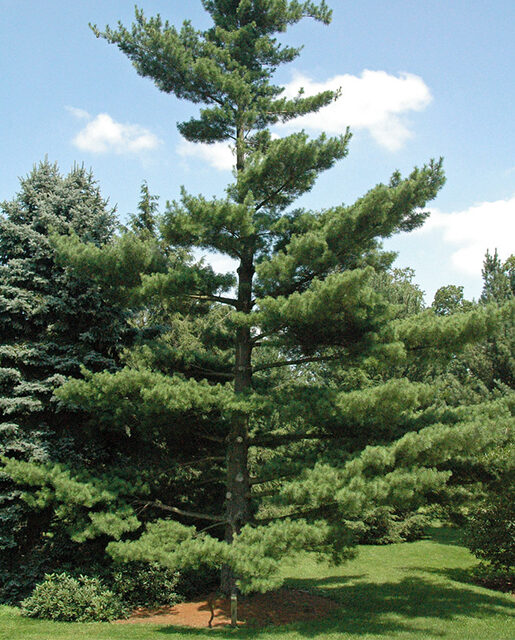Pinus strobus
In the 18th century, the King of England claimed large numbers of white pines to be used as masts for navy ships, due to their durable lumber. This led to rising tensions between England and its colonies, eventually resulting in the “Mast Tree Riot.”
Location
Today, the Arboretum is still home to well over thirty white pine trees. You may see some as you drive along May or Lovell Street. If you’re inside the Arboretum, see if you can spot them as you walk along Elderberry Trail.


History at Hadwen
The first planting of the white pine in the Hadwen Arboretum was in 1846. Hadwen admits that they were originally planted more with the purpose of shelter than for ornamental effect, and jokes that by 1900 they had been broken by storms and ice and would “make good saw logs.” Hadwen seemed to be aware of their increasing popularity, and attributed this to “their symmetry of form and varying shades of everlasting green, and the beauty and grandeur of individual trees.”
Keep Learning
Detailed Species Information
Eastern white pine is a large evergreen tree in the family Pinaceae native to the great lakes region, parts of southeastern Canada, and the eastern United States. These trees were once distributed in a much larger territory, but have declined in population due to the extensive logging of the 18th, 19th, and 20th centuries. This tree is one of the tallest species in North America, reaching heights of over 200 feet (55 meters). White Pine trees also typically live for 200 to 250 years but can live much longer, with some trees reportedly living over 500 years. The diameter of mature pines ranges from 3–5 feet (1–1.6 meters). They are characterized by a straight trunk with evenly spaced branches. Like most species in the family Pinaceae, eastern white pine leaves are a bundle of needles usually in groups of five. The cones of eastern white pine are large and contain seeds that are typically dispersed by the wind.
Eastern white pine prefers well-drained or sandy soils, but is tolerant to conditions such as wetlands or rocky highlands. Typically, the eastern white pine stands taller than other trees in the forests and provides critical habitat for numerous species of birds and small mammals. Despite being a hardy and fire-resistant species, eastern white pines are vulnerable to the white pine weevil (Pissodes strobi) and white pine blister rust (Cronartium ribicola). White pine blister rust, an introduced fungus, causes high mortality rates (50–80%) in eastern white pines, leading to devastating effects on crucial wildlife habitats and the timber industry.
Eastern white pine has been a prized source of quality lumber since the 17th century. Famously, the British king marked the largest white pines for exclusive use as ship masts for the British Royal Navy. This fueled tensions between colonies and England, eventually culminating in the “Pine Tree Riot,” an important event leading to the American Revolution. Today, eastern white pines are still used for timber framing and widely cultivated as ornamental trees for landscaping due to their low maintenance and quick growth.
